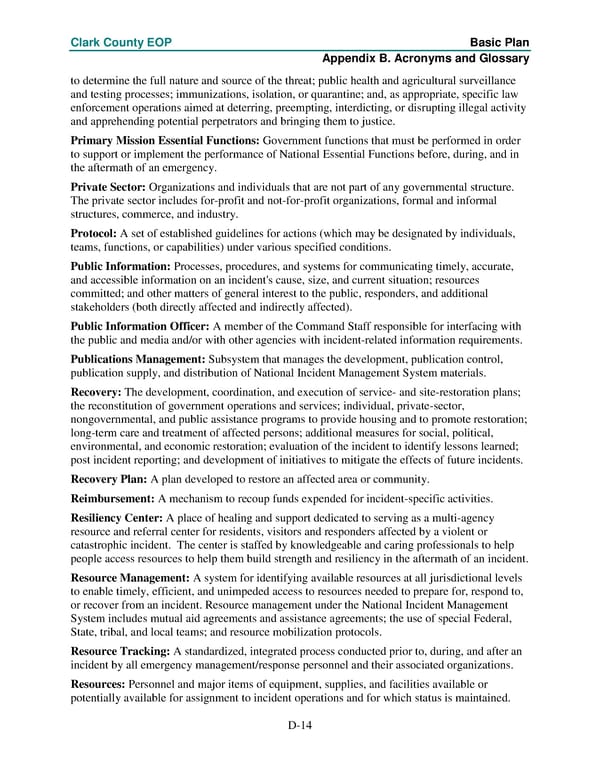Clark County EOP Basic Plan Appendix B. Acronyms and Glossary to determine the full nature and source of the threat; public health and agricultural surveillance and testing processes; immunizations, isolation, or quarantine; and, as appropriate, specific law enforcement operations aimed at deterring, preempting, interdicting, or disrupting illegal activity and apprehending potential perpetrators and bringing them to justice. Primary Mission Essential Functions: Government functions that must be performed in order to support or implement the performance of National Essential Functions before, during, and in the aftermath of an emergency. Private Sector: Organizations and individuals that are not part of any governmental structure. The private sector includes for-profit and not-for-profit organizations, formal and informal structures, commerce, and industry. Protocol: A set of established guidelines for actions (which may be designated by individuals, teams, functions, or capabilities) under various specified conditions. Public Information: Processes, procedures, and systems for communicating timely, accurate, and accessible information on an incident's cause, size, and current situation; resources committed; and other matters of general interest to the public, responders, and additional stakeholders (both directly affected and indirectly affected). Public Information Officer: A member of the Command Staff responsible for interfacing with the public and media and/or with other agencies with incident-related information requirements. Publications Management: Subsystem that manages the development, publication control, publication supply, and distribution of National Incident Management System materials. Recovery: The development, coordination, and execution of service- and site-restoration plans; the reconstitution of government operations and services; individual, private-sector, nongovernmental, and public assistance programs to provide housing and to promote restoration; long-term care and treatment of affected persons; additional measures for social, political, environmental, and economic restoration; evaluation of the incident to identify lessons learned; post incident reporting; and development of initiatives to mitigate the effects of future incidents. Recovery Plan: A plan developed to restore an affected area or community. Reimbursement: A mechanism to recoup funds expended for incident-specific activities. Resiliency Center: A place of healing and support dedicated to serving as a multi-agency resource and referral center for residents, visitors and responders affected by a violent or catastrophic incident. The center is staffed by knowledgeable and caring professionals to help people access resources to help them build strength and resiliency in the aftermath of an incident. Resource Management: A system for identifying available resources at all jurisdictional levels to enable timely, efficient, and unimpeded access to resources needed to prepare for, respond to, or recover from an incident. Resource management under the National Incident Management System includes mutual aid agreements and assistance agreements; the use of special Federal, State, tribal, and local teams; and resource mobilization protocols. Resource Tracking: A standardized, integrated process conducted prior to, during, and after an incident by all emergency management/response personnel and their associated organizations. Resources: Personnel and major items of equipment, supplies, and facilities available or potentially available for assignment to incident operations and for which status is maintained. D-14
 Emergency Operations Plan Page 117 Page 119
Emergency Operations Plan Page 117 Page 119